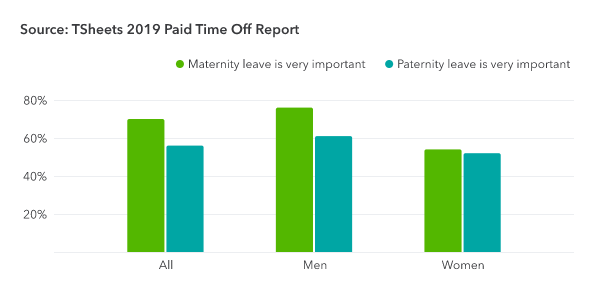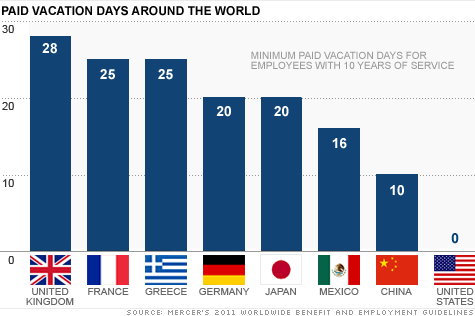This article is for organizations that want to know what accrued time off is, its benefits for a business, and how to manage it efficiently. We will also talk about the laws surrounding vacation accrual along with tools to navigate PTO in the United States.
What is PTO?
PTO is a pool of different types of paid leaves offered to an employee by an employer. It includes vacation leave, sick leave, holidays, or personal leave. Many people think PTO and vacation are similar.
But in reality, these are two different time-off concepts. An employee can take a vacation without pay. But when it comes to PTO, employees can make their hourly rate even while working out of the office.
Who Will Determine PTO?
You see, the American workforce is eligible for up to 12 weeks of time off as per the Family and Medical Leave Act. But there is no regulation for this time off to be paid by Federal Law.
It means that it is up to the state laws and the management to govern vacation accrual.
But companies have found that offering generous PTO plans is a great way to attract and retain productive employees in the workforce.
What is Accrued Time?
Accrued time is a specific type of paid time off (PTO) given to the employees that accrue to them basis the time spent in the organization. It is a paid leave program wherein all the earned leaves are accumulated together.
Often companies chose to give accrued time off, rather than offering separate leave balances for personal days, sick days and paid vacation time. The companies prefer to create a single pool of PTO that employees can earn and accrue over time.
Employees of an organization, by and large, earn their PTO on an hourly or daily basis. These leaves are then accumulated in a PTO bank. Now, the employees are free to use their PTO according to their date of joining, after an interim period, or by the vacation accrual policy of the company.
The management has full authority to create this policy, there are no federal mandates for paid time off. It can be absolutely anything from 15 days plus organization-observed holidays. to two months of vacation time, no questions asked. PTO experts say that unclassified paid leaves allow the employees to use their time off as they would like.
By not labeling leaves as sick, personal, or vacation, the burden on HR is reduced considerably. We, at AttendanceBot actually enjoy an unlimited time-off policy that is useful to both employees and the company.
A report from TSheets states that over 76% of the USA’s working population believes that every organization should offer paid vacation time to its employees. With over 70% stressing the importance of paid parental leave to raise children.
Are Companies Required to Offer PTO to its Employees?
US Federal Law does not require every company in the U.S. to offer PTO to employees. However, specific states have made it mandatory for organizations to pay employees for unused time off or paid sick time. For example, PTO is compulsory in states like Illinois, California, Indiana, Montana, Massachusetts, West Virginia, and Rhode Island.
Moreover, it is also mandatory for businesses operating in these States to have a structured PTO policy. On the other hand, states like Florida, South Dakota, Idaho, Wyoming, and Virginia have no mandating laws for PTO.
Irrespective of the state requirements, many companies still believe in offering accrued time off to their employees. In the competitive employment market, it helps in attracting top talent and creating a healthy and loyal workforce.
Although a lot of companies do not have the policy to carry over accrued time off many have temporarily relaxed this rule amid COVID-19. Apart from motivation, vacation accrual also minimizes unscheduled absences that can negatively impact an organization’s operations.
What are the Different Types of Paid Time Off?
Although many employees associate PTO with sick time or vacation time, it is much more than that. Ideally speaking, the definition of PTO applies to any employee who is not working.
There are different types of PTO that every employer and employee should be aware of. They are:
- Sick Time
- Vacation Time
- Personal Days
- Federal Holidays
- Bereavement Leave
- Floating Holidays
- Jury Duty
- Parental Leave
- Community Service
How Does PTO Work?
The structure and current policies of an organization determine the working of PTO. The company structure will ascertain the guidelines and the amount of PTO an employee can take. Ideally, organizations have three options to decide how their PTO policy will work. Let us have a look at them:
Traditional Paid Time Off System
The employees get a fixed number of leaves in a year. The employees can use it in days or hours as per their convenience. Employers also have the authority to divide their PTO into different categories like personal leaves, sick days, or vacation.
Some companies increase the amount of PTO as the employee tenure with the organization increases. However, employees still need to request time off in advance from their managers.
PTO Bank System
As the name suggests, the PTO bank system consolidates all the time off in a single pool. There is no classification into vacation types like sick, vacation, or personal leaves. Employees can use their leaves as and when they require without letting the company know why they’re taking one.
The best part about using the PTO bank system is that it makes leave calculation very easy for the management. Employees can also plan their leave utilization to take optimum advantage of the PTO bank system.
Unlimited PTO System
It is a result-driven PTO system wherein the organization does not set any prior limit for time off. This system allows the employees to enjoy time off unless it disrupts productivity and work schedules.
Unlimited PTO system gives the most significant amount of flexibility to the employees. Although employers need to keep track of the total time off taken by an employee, they can allow leaves as per their discretion and work commitments.

Does PTO Accrue?
What happens when for any reason, an employee is unable to use their PTO? You see, only a few states in the US have PTO laws. It requires the companies to pay for employees for every unused leave or roll over it to the next financial year.
For instance, California companies are legally bound to carry forward unused PTO to the following year. If an employee has used 40 hours out of his 48, the next year will start with 8 hours PTO.
However, companies in other states can also go for a use-it-or-lose-it-policy. It means that the leaves will lapse if the employees fail to avail their PTO in the financial year it is earned.
Which States give the Highest PTO?
Since the legislators have left the PTO plans at the discretion of the organizations, states with higher employment concentration tend to guarantee better PTO.
According to a survey by Quickbooks, Northeast American states like Maine, Massachusetts, New York, Vermont, New Hampshire, Rhode Island, Delaware, Connecticut, Pennsylvania, and New Jersey offer the highest PTO days for their employees. It is almost 18% higher than the national average. On the other hand, Southeast and Midwest states offer the least PTO days to their employees.
How many PTO days are Granted by State Law?
You see, only 12 states, along with Washington DC, presently have constituted vacation accrual programs. Nevada and Maine passed this law in 2019. However, they only have the vacation accrual policies that overtly say that state-mandated time off is used for things other than illness.
- In California, Arizona, Michigan, New Jersey, Maryland, and Oregano, employees can earn one hour off for every 30 hours of working.
- In Rhode Island, employees can enjoy around 35 hours of PTO in a financial year.
- For states like Maine, Washington, Connecticut, and Nevada, employees earn one hour of time off for every 40 hours of working.
- Employees working in Vermont can earn one paid hour of vacation for every 52 hours of work.
- People working in D.C. can earn one hour of PTO for 37-87 hours of working. However, the final PTO depends upon the size of the organization.
Please note that all these states have different rules when it comes to vacation accrual. This rule also applies to PTO usage. Some states have a capping accrual of 40 hours, while others have a capping accrual of 48 hours.
However, the employees are recommended to check with the state’s PTO rules and regulations to understand better.
How to Keep a Track and Calculate PTO?
Tracking PTO involves a lot of work like managing accrual caps, rates, payouts, and limits. Selecting a self-service vacation accrual software will also act as a seamless PTO accrual calculator for the companies. It will save HR from constantly fielding PTO-related queries from harried employees. Employees can simply check their PTO status on the application and apply for leaves too.
With applications like AttendanceBot that is free for up to 5 users, companies can automate the entire leave process. It makes leave accrual, applying for leaves, leave approvals, calendar syncs, and leave announcements completely seamless.
But if you are not ready to use a simple software on Slack or Teams yet, calculating vacation accrual is actually pretty easy for a few employees.
- Enter the total number of vacation days an employee has earned in the financial year.
- Deduct the total time off taken by the employee that year and This will give you their PTO balance.
- Depending on your company’s vacation accrual policy, roll over the entire balance or the percentage mentioned in the policy to the next year.
Best Practices to Develop a Vacation Accrual Policy
A vacation accrual policy is the set of rules and regulations that employees need to follow while availing their PTO. Following are the best practices that will help the management in getting the PTO policy right in the first go.
Seek Employee Feedback
The first and foremost thing that organizations should do is solicit employee feedback. Let them give their preference when it comes to different PTO accrual options. Ultimately, they are the ones who have to use the policy for their well-being.
Make it Attractive
The management must make sure that it comes with a PTO policy that has a perfect combination of accountability and flexibility.
Flexibility to choose from different types of PTO and a hassle-free process to take time off will boost the morale of employees. Accountability to the extent that employees are accountable to take their planned time off in accordance to time off being taken by other employees.
The Policy should be Comprehensive
A PTO policy must be clearly defined and understandable. The higher clarity, the higher employee satisfaction in the organization. It will also curb organizational issues like absenteeism and any conflicts.
Finally, the management must ensure that its PTO policy covers every section of its workforce.
Consider the Company Culture
An unlimited vacation accrual policy might sound great on paper. But your company culture and schedules must align to have such a flexible time-off policy.
Therefore, it is crucial to have an excellent understanding of the company culture, industry trends, and employee expectations while formulating a PTO policy.
Incentives or Benefits
Organizations with a use-it or lose-it PTO policy must understand that it can demotivate the employees. On the one hand, the employees are given paid time off. But on the other hand, it is snatched away at the end of the year because they were too busy fulfilling their professional commitments.
Experts recommend converting unused time off into employee benefits or incentives. Paying student loans, emergency expenses, or sponsoring a holiday are creative ways to create a loyal workforce while making sure that they can unwind.
Organizations should try to introduce innovative PTO measures to boost the productivity and morale of the employees. Offering sabbaticals, forced time off, floating holidays, and combined PTO banks are other tips for designing an efficient 21st-century vacation accrual program.
It is an intelligent way of thinking about an employee’s time off. Investing in a time off application like AttendanceBot can also help managing leave requirements in large organizations. It is an all-in-one leave solution that makes monitoring work hours and managing time off a breeze. Opt for a Free Demo or just take AttendanceBot for a spin on your workspace today.





